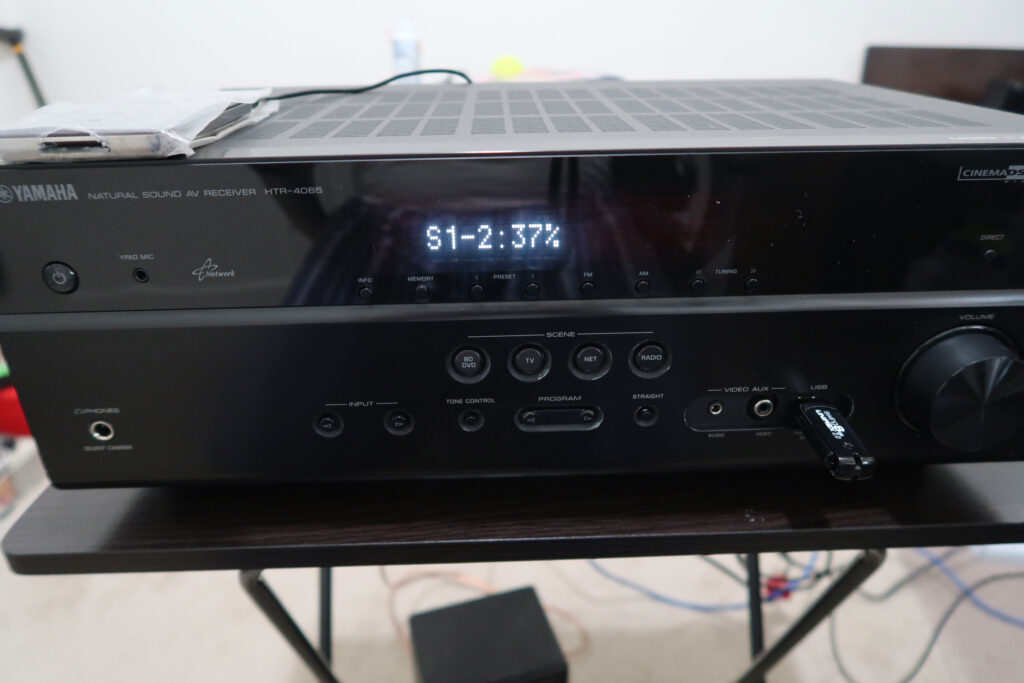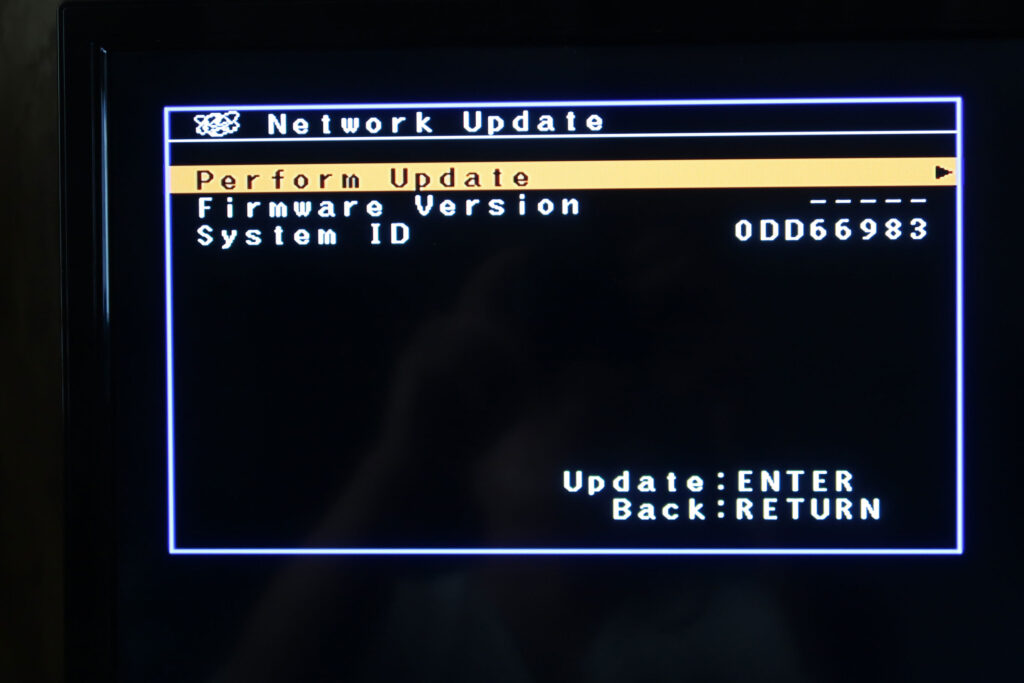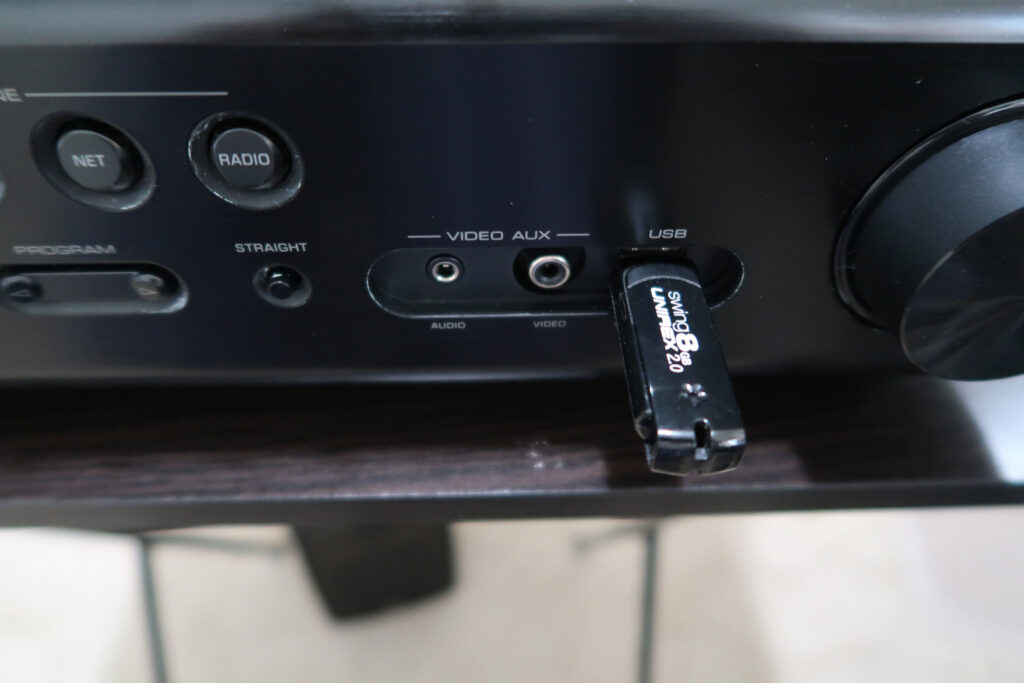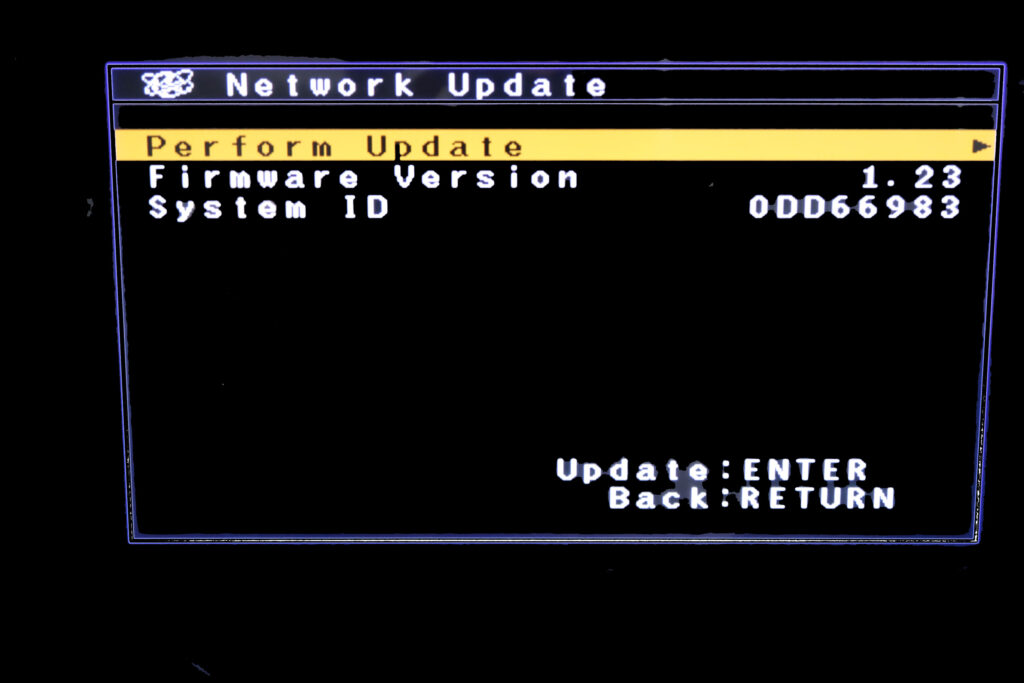In early 2015, after deciding to replace my aging AIWA (AV-D97) audio-video receiver with a unit capable of audio streaming, three (3) of my criteria were 1): several HDMI ports, 2): 1 or 2 USB ports, and 3): an Ethernet port.
After scrounging the web for a reasonably-priced, networked AV receiver unit that matched the specs I wanted, I finally settled on the Yamaha HTR-4065, which someone from the nearby city of San Jose (California) sold to me for about $175.
I did not bother to test the unit at the house of the middle-aged fellow that fateful mid-winter morning. When I saw the unit came in the original but a bit worn-out box and looked relatively new, I trusted my instincts that it was a fully functioning unit.
Also included were an almost brand-new remote control (RAV464), the Easy Setup Guide, plus a bounded photocopy of the 107-page owner’s manual.
After handing out my payment, I rushed home to celebrate my new “score.” At that time, similar units were selling for more than double my price.
What a deal! Or, so I thought.
Joy turned into frustration after I hooked up my speakers and connected my iPod Classic – via the USB port or the audio out (AUX) jacks- and no sound of music came out of the unit. I looked up the manual to see if I needed to push a button (or a combination) to produce audio. I also tried using a few headphones, but no audio came from them.
No luck. No audio, No matter what kind of device I use, the unit’s front or back audio inputs.
Either someone just sold me -knowingly or unknowingly- a defective AV receiver, or, by the stroke of fate, something had gone wrong with the unit after I picked it up.
What puzzled me was this: The unit was almost brand-new. It powered up and all the buttons and display on the receiver worked, as well as all the video signals. However, it did not seem to be sending audio signal to any of the speaker channels which led me to believe there was a problem specifically with the amplifier. There was no error message on the display. I heard the sounds of different relays clicked when it powered up.
Even after I opened the unit to check for frayed wires, loose connectors, bad capacitors, poorly soldered contact points, etc., I admitted defeat. And with it, the hollow feeling that I had just thrown away $175.
I put the ‘bad’ AV receiver back into its box, stored it in the big shed in our backyard, and forgot about it after I picked up another – and more expensive- networked AV receiver (Sony STR-DN1030) a few days later in Santa Rosa, CA. I tested that unit thoroughly before I handed out my money. It still serves us well in the spare bedroom.
Just recently, but more than six (6) years later, I laid my eyes on the box where I stored the ‘defective‘ Yamaha AV receiver. The box had sat atop a table where I usually put most of my power tools, vintage computers, and other bulky electronic accessories or gadgets I had collected through the years.
Many items that had sat on top of that table had either gone straight to the brown trash cart or the sidewalk in front of the house – where the garbage company’s big truck collects most of our no-longer-wanted (aka junk) household items twice a year.
On a whim, I took out the Yamaha AV receiver from its box, put fresh AAA batteries into the remote, and connected a pair of vintage Model S6 Polk Audio speakers as well as a 17″ LED TV (via the HDMI out port) that I have in the same shed. I attached a Sony Discman via the audio out port and prayed that things may have changed for the better after those six years.
Same result – no audio, no music. Either from any device, I attached to the audio out port or via the built-in tuner. It was the same frustrating experience I had with the unit in early 2015.
But this time, I decided to check out the unit’s system interface details, starting with the Setup menu (accessible via the remote by pressing the orange-coded SETUP button).
Since the unit did not have Wi-Fi capability and the only Internet access I had on the shed was via Wi-Fi, I brought the unit inside the house and connected it to one of the ports on the Netgear gigabit switch – after I had hooked up my old pair of Aurex SS-S12W bookshelf speakers (part of the Toshiba Aurex System 10 set).
Under the Setup menu are Speaker, HDMI, Sound, ECO, Function, Network, and Language sub-menus. I won’t go into the details of each item under each sub-menus, but I tried all the possible settings under each – still no audio, no music.
I read the owner’s manual and searched the web for possible causes of why a relatively unused Yamaha HTR-4065 AV receiver would produce no audio. As I mentioned, it powers up, all the buttons and displays on the receiver work, and all the video signals. It is also easier to navigate the menus using the remote control.

The closest result I got was from a person with the same issue I had, who posted his woes on the forum of Audioholics (an online A/V magazine) sometime in July 2016. Other users on the forum have different suggestions: that the no audio issue is related to “overheated HDMI ports”; another said the issue was due to “a power supply problem to the audio section” (duh – how convenient!). Another member wasn’t helpful and suggested: “Just toss out the unit in the garbage bin.”
What caught my attention on the same forum was this: “Have you done a reset to default factory settings and reset the unit up?” So, I headed to Yamaha’s website and downloaded the PDF version of the owner’s manual to read it better on my big computer monitor.
From the web: Yamaha HTR-4065 Factory Reset
- Set the unit to Standby Mode using the Power button.
- While holding down the Straight button, hit the Power button.
- Use the Program Selector buttons to navigate to INIT CANCEL and press the Straight button to select ALL.
- When the proper selection is made, turn off the unit using the Power button.
I did the factory reset 2 or 3 times to no avail – same, no audio, no music result.
Then it dawned on me that since the advent of “networked everything,” almost all devices connected to the web rely upon microprocessors and embedded software (firmware) for their operations. Firmware upgrades are typically done automatically via the web to improve their functionalities.
My ‘defective’ Yamaha HTR-4065 AV receiver could be a victim of a botched firmware update!!!
Excitedly, I focused on the Network submenus (IP Address, MAC Address Filter, DMC Control, Network Standby, Network Name, Information, and Network Update) to make sure that the AV receiver was connected correctly to my network to access the Internet – and, yes, it was!!!

I drilled down to the Network Update submenu (Perform Update, Firmware Version, and System ID) and, under Perform Update, tried to update the firmware. Curiously, under Firmware Version, nothing showed up except a slew of dashes – which only bolstered my theory that the AV receiver was a victim of a firmware update that went awry.
However, the firmware update via the network did not happen. It spewed out a ‘System Error’ message on the AV receiver’s display panel and the computer monitor where I connected the AV receiver via the HDMI OUT port.

The rest was easy. I had been doing it on most of my old or new devices, updating the firmware via the USB port.
I downloaded the latest firmware (v 1.23) for the HTR-4065 (and models HTR-5065, RX-V473, and RX-V573) from Yamaha’s website. I then transferred the .bin file (R0305-0123) to the root of the FAT32-formatted USB drive I have (8 GB). Finally, I did the update via the unit’s only USB port on the front panel (to the left of the volume control knob).
The update took a while (between 5 to 10 minutes) but was successful. After I confirmed that the latest firmware registered correctly under Firmware Version, I pressed the right (>) Input button to get me to AUDIO mode. I pressed on the PLAY button of the Sony Discman, and voila, — refreshing “natural sound” of music from my Yamaha HTR-4065.
Finally, after almost six (6) long years.

EPILOGUE: Though lacking Wi-Fi and Bluetooth features, which my Sony STR-DN1030 has, I like the larger LED display on the Yamaha and the fewer but well-laid-out function buttons.
Also, Yamaha’s NET Radio feature is much better than Sony’s diminishing Internet audio streaming partners like vTuner. Sony terminated the service for most of its networked audio products, including the STR-DN1030, in September 2015.
You will shell out $4 for a year’s subscription to access all the features of Yamaha’s Internet radio/podcast portal. They use vTuner’s API and source code -(yradio.vtuner.com). The simple and easy-to-use interface more than pays for all the musical goodies you’ll get over the web on their older model of networked AV receivers, such as the HTR-4065.
And, just like most newer devices, you can control most of the features of the Yamaha HTR-4065 on your phone or tablet via the Yamaha AV Controller app (the latest version is 5.51). If the app does not detect your compatible device automatically, enter the IP address of your unit manually once you have hooked it up to your home network via Ethernet, and you’re good to go.
In late 2016, Yamaha utilized the same portal (this time, a free service) for their new models of networked AV receivers, including the WXA-50 and WXC-50.
They also added many popular audio streaming sites like Spotify, Pandora, Napster, Sirius XM, Rhapsody, and hi-res audio streaming sites like Deezer and Tidal. They renamed the app to their multi-room audio system, MusicCast.
2022 UPDATE: I renewed my vTuner’s yearly subscription, up to $5 from $4.
Sept. 2023 UPDATE: I renewed my vTuner’s yearly subscription, which went up to $6 from $5.

